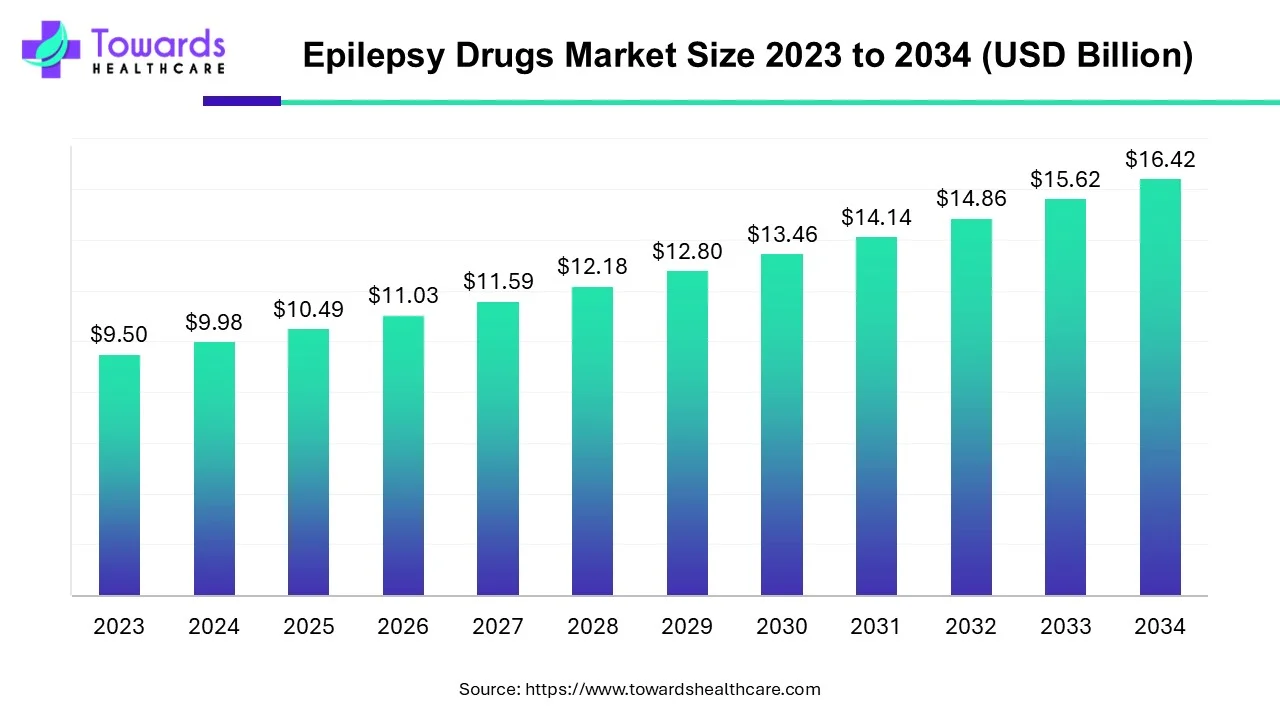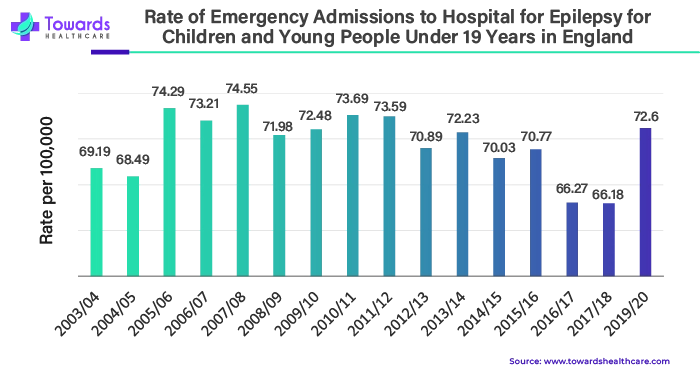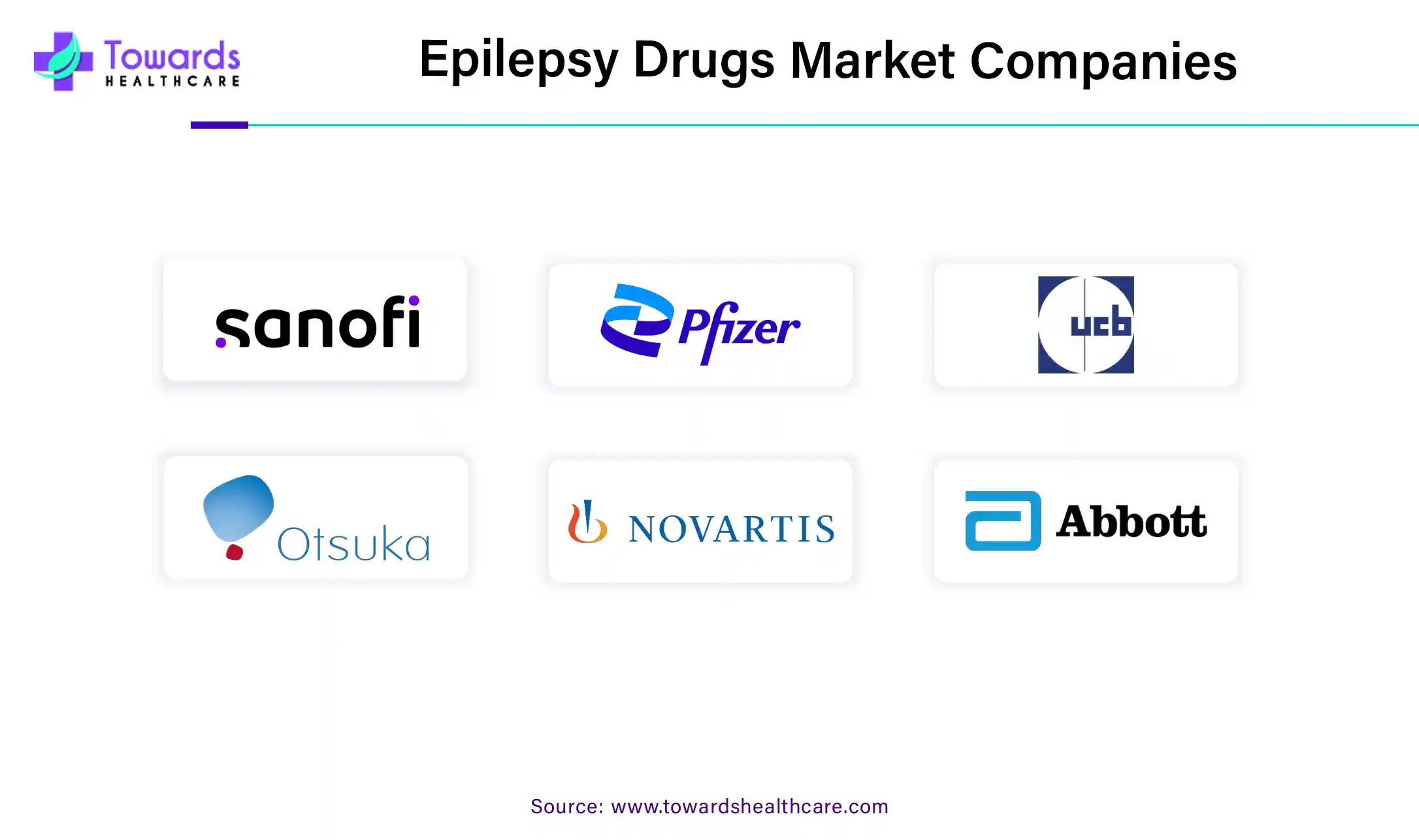November 2025

The epilepsy drugs market size is projected to reach USD 16.42 billion by 2034, growing from USD 10.49 billion in 2025, at a CAGR of 5.1% during the forecast period from 2025 to 2034.

According to the World Health Organization, approximately 50 million people in the United States have epilepsy, and they are at a higher risk of premature death as of February 2024.
Epilepsy is a neurological disorder marked by recurring seizures, which happen when the brain experiences sudden bursts of electrical activity, disrupting normal function temporarily. Symptoms vary among individuals, ranging from mild to severe. Seizures can show up as convulsions, muscle spasms, loss of consciousness, blank staring, or unusual movements. After a seizure, people might feel confused, have memory lapses, or struggle with speaking. Some seizures lead to brief disconnection from surroundings or psychic symptoms like fear or deja vu beforehand. Treating epilepsy is essential for several reasons. It aims to reduce seizure frequency and severity, making life better for those affected. Safety is a big concern, as seizures can cause accidents during tasks like driving or swimming.
Epilepsy is like an electrical storm in the brain, causing sudden bursts of activity that lead to seizures. These seizures can take various forms, from convulsions where muscles jerk uncontrollably to moments of blank staring where the person seems temporarily lost. Imagine it like a short circuit in the brain's wiring.
Now, why is it important to treat epilepsy? Well, think of it this way, if left untreated, these electrical storms can wreak havoc on a person's life. They can strike at any time, putting the person in danger of accidents or injuries. Not to mention, they can make everyday activities like driving or working a lot riskier. But it's not just about safety; epilepsy treatment also aims to give people their lives back. Imagine living in constant fear of when the next seizure might hit. It can be mentally and emotionally exhausting. Treatment can help reduce the frequency and intensity of seizures, giving people more control and peace of mind.
For instance,
Uncontrolled seizures can mess with the brain's functions over time. They can affect memory, concentration, and even mood. It's like having a glitch in the brain's system that keeps getting worse if not addressed. And let's not forget about the social aspect. Imagine feeling embarrassed or scared to go out in public because you're afraid of having a seizure in front of others. It can make forming and maintaining relationships challenging.
Treating epilepsy isn't just about stopping seizures; it's about restoring safety, control, and quality of life. It's about giving people with epilepsy the chance to live their lives to the fullest, without the constant fear and uncertainty that seizures bring.
Around 50 million people worldwide are estimated to have epilepsy, making it one of the most prevalent neurological disorders globally. In the UK alone, epilepsy affects an estimated 112,000 children and young people, making it the most common significant long-term neurological condition during childhood.

More people are being diagnosed with epilepsy worldwide, which is leading to a big increase in the need for epilepsy drugs. People with epilepsy rely on these drugs to control their seizures and improve their lives. Because of this growing demand, the amount of epilepsy medication being used and the money spent on it is going up in many parts of the world. Imagine it like this, if more people are getting sick with epilepsy, there's a greater need for medicines to help them feel better. It's like when there's a sudden surge in the number of people catching a cold, pharmacies need more cold medicine to meet the demand.
This rise in epilepsy cases could be due to various factors, including better awareness and understanding of the condition, improved diagnostic techniques, and changes in lifestyle or environmental factors. With more awareness about epilepsy, more people are seeking medical help, leading to higher demand for medications. The growing population also plays a role. As the world's population increases, so does the number of people affected by various health conditions, including epilepsy. More people means more potential patients needing treatment.
As healthcare systems become more advanced and accessible, more people have access to medical care, including epilepsy diagnosis and treatment. This further contributes to the increasing demand for epilepsy drugs. Additionally, factors like aging populations, where epilepsy is more common among older adults, and the rising incidence of epilepsy-related conditions such as traumatic brain injuries or strokes, also drive the need for epilepsy medications.
The rising prevalence of epilepsy worldwide means more people require treatment, resulting in a growing demand for effective epilepsy drugs to help manage the condition and improve patients' lives.
Government initiatives play a crucial role in boosting the epilepsy drugs market by focusing on raising awareness, improving diagnosis, and enhancing treatment options for those affected. These initiatives involve various efforts, such as public education campaigns, healthcare provider training programs, and community outreach events, to increase understanding about epilepsy and its management.
For instance,
Additionally, governments allocate funds for research and development in epilepsy, supporting scientists and pharmaceutical companies in discovering new treatments and improving existing ones. This funding enables the development of more effective and safer medications for managing epilepsy. Imagine it as if the government is investing money in scientists and researchers to find better ways to treat epilepsy, like finding new and improved medicines or developing innovative therapies.
By investing in epilepsy research, governments aim to find breakthroughs that can revolutionize epilepsy treatment, leading to better outcomes for patients. These advancements not only benefit individuals with epilepsy but also contribute to the growth of the epilepsy drugs market, as healthcare providers adopt new treatment options backed by research evidence.
First-generation anti-epileptic drugs have been around for a while and are still widely used to treat epilepsy. They include medications like phenobarbital, phenytoin, and carbamazepine. These drugs have played a significant role in epilepsy treatment.
For instance,
Imagine it like this: these are the older, tried-and-tested medicines that doctors have been using for a long time to help people with epilepsy. They're like the backbone of epilepsy treatment. While newer medications have been developed, first-generation anti-epileptic drugs still make up a significant portion of the epilepsy drugs market.
These drugs are often the first choice for many patients because they're effective in controlling seizures and are generally less expensive compared to newer options. So, despite the availability of newer drugs, first-generation anti-epileptic drugs continue to be widely prescribed, driving the market for epilepsy treatment.
Epilepsy isn't always alone; it often comes with other health issues like psychiatric disorders or problems with thinking. When someone has epilepsy along with these other conditions, it makes treating them more complicated. Imagine it like trying to solve a puzzle with lots of pieces that don't quite fit together perfectly.
For instance,
If someone with epilepsy has trouble with their memory or thinking, it can make it harder for them to manage their epilepsy. They might forget to take their medication or have trouble understanding their treatment plan. It's like having an extra challenge to deal with on top of the epilepsy itself. All these extra complications can mean more doctor visits, more tests, and more medications, which can add up and increase healthcare costs. It's like needing more pieces to solve the puzzle, which can make things more expensive and take more time to figure out. When epilepsy comes with other medical conditions, it's like dealing with a more complex puzzle that requires careful attention and planning to manage effectively.
North America is a big market for epilepsy drugs worldwide because they spend a lot on healthcare, have really good hospitals and clinics, and there are many people with epilepsy there. The rules for approving and selling epilepsy drugs in North America are strict. The U.S. Food and Drug Administration (FDA) and Health Canada check if the drugs are safe, work well, and are good quality before they're sold. This makes patients feel safe using them. People in North America usually rely on their insurance to pay for epilepsy drugs. Whether it's private insurance or from the government, having good coverage helps people get the drugs they need. When insurance plans cover more of the cost, it can affect which drugs doctors prescribe and how the market for epilepsy drugs works.
For instances,
Rapid economic growth in many Asian countries means more money is spent on healthcare, and people can get better access to medical help. Because of this, there's a higher demand for epilepsy drugs since more folks are seeking treatment for neurological issues. In different parts of Asia, there are different rules about approving drugs, setting prices, and protecting intellectual property rights. This can make it tricky for drug companies to sell epilepsy drugs in many countries. Also, people in Asia have different ideas and feelings about epilepsy, which affects how they see it and how likely they are to seek help. So, it's important to understand these cultural differences and educate people about epilepsy to make sure everyone who needs treatment can get it.
In the market of epilepsy drugs, there are several companies making medication to help manage seizures. These drugs work in different ways and come in different forms like pills and liquid. Some companies make generic versions of these drugs, which are often cheaper. These companies are always trying to make better drugs that work more effectively and have fewer side effects. Getting approval from the regulators, reaching more patients, setting prices, and working with healthcare providers are all important for these companies to compete in the market.

By Product Type
By Distribution Channel
By Geography
November 2025
November 2025
November 2025
November 2025